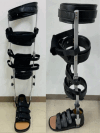Influences of Gait Training with Knee-Ankle-Foot Orthosis on Gait Ability and Independence in Severe Hemiplegia and Pusher Behavior with Unilateral Spatial Neglect Following Stroke: A Retrospective Historical Controlled Study
- PMID: 40534213
- PMCID: PMC12177197
- DOI: 10.1002/brb3.70535
Influences of Gait Training with Knee-Ankle-Foot Orthosis on Gait Ability and Independence in Severe Hemiplegia and Pusher Behavior with Unilateral Spatial Neglect Following Stroke: A Retrospective Historical Controlled Study
Abstract
Background: Orthotic therapy is crucial for post-stroke patients with severe motor paralysis and higher brain dysfunction, including pushers and unilateral spatial neglect (USN). These patients exhibit impaired postural control and compromised independence in activities of daily living (ADLs), often necessitating mid- to long-term intervention using knee-ankle-foot orthoses (KAFOs). However, the influences of extended orthotic intervention in severe and pusher cases remain unclear. The purpose of this study was to examine the influences of KAFO on walking ability and independence in severe hemiplegia with pusher and USN and pusher cases who wore KAFO and performed training routinely for more than 3 months.
Methods: This longitudinal, retrospective, and historical controlled study included 44 patients: 22 hemiplegics (hemiplegia group) and 22 pushers (pusher group). Demographic data were matched using a propensity score to adjust for heterogeneity, resulting in a 1:1 patient ratio. KAFOs in both groups were defined as those used within 1 week of the rehabilitation prescription date. This mean as motor paralysis was severe, patients who used KAFOs for at least 3 months in rehabilitation situations. Outcomes comprised the following: procedure A, comparing ambulation at admission and discharge (functional ambulation category [FAC]) and gait independence (FIM-gait) between groups;and procedure B, investigating factors affecting gait ability, and determinants of pusher behavior with USN presence, derived from demographics. In statistical analyses, procedure A employed two-way analysis of variance with Bonferroni post-hoc tests (p<0.05), whereas procedure B employed multiple regression analysis (Stepwise method) to examine gait independence within the two groups, and logistic regression analysis (Wald method) was used to examine factors that generate pusher behavior with USN.
Results: In using orthotic devices, a significant interaction between gait independence and FAC, along with a simple main effect of timing and group, indicated less improvement at discharge for the pusher group (p < 0.05). Onset days and SPV variability errors influenced severe hemiplegia cases, whereas SPV-EO variability errors impacted USN cases, with moderate regression coefficients (p < 0.05).
Discussion: Long-term KAFO intervention demonstrated improvement in severe hemiplegia and modest improvement in USN cases. The days since onset and SPV variability errors were crucial factors influencing gait independence in severe hemiplegia, whereas SPV-EO variability errors influenced a role in determining gait independence in patients with USN. This hindered gait independence in patients with pusher pain and USN, despite observed improvements in gait ability over time during the recovery process.
Keywords: gait abilities; independence; knee–ankle–foot orthosis; pusher; severe stroke.
© 2025 The Author(s). Brain and Behavior published by Wiley Periodicals LLC.
Conflict of interest statement
The authors declare no conflicts of interest.
Figures



Similar articles
-
Analysis of the Recovery Process and Activities of Daily Living Independence in Pusher Behavior and Unilateral Spatial Neglect.Arch Phys Med Rehabil. 2025 Mar;106(3):387-396. doi: 10.1016/j.apmr.2024.09.019. Epub 2024 Oct 26. Arch Phys Med Rehabil. 2025. PMID: 39490804
-
Effect of different designs of ankle-foot orthoses on gait in patients with stroke: A systematic review.Gait Posture. 2018 May;62:268-279. doi: 10.1016/j.gaitpost.2018.03.026. Epub 2018 Mar 16. Gait Posture. 2018. PMID: 29587246
-
Randomized, crossover clinical trial on the safety, feasibility, and usability of the ABLE exoskeleton: A comparative study with knee-ankle-foot orthoses.PLoS One. 2025 May 27;20(5):e0318039. doi: 10.1371/journal.pone.0318039. eCollection 2025. PLoS One. 2025. PMID: 40424335 Free PMC article. Clinical Trial.
-
The effects of orthoses, footwear, and walking aids on the walking ability of children and adolescents with spina bifida: A systematic review using International Classification of Functioning, Disability and Health for Children and Youth (ICF-CY) as a reference framework.Prosthet Orthot Int. 2015 Dec;39(6):437-43. doi: 10.1177/0309364614543550. Epub 2014 Aug 8. Prosthet Orthot Int. 2015. PMID: 25107922
-
Early knee-ankle-foot orthosis wear shortens hospital stays and improves activities of daily living in patients with stroke.Prosthet Orthot Int. 2025 Aug 13. doi: 10.1097/PXR.0000000000000480. Online ahead of print. Prosthet Orthot Int. 2025. PMID: 40794427
References
-
- Babyar, S. R. , and Peterson M. G.. 2017. “Reding M: Case‐Control Study of Impairments Associated With Recovery From “Pusher Syndrome” After Stroke: Logistic Regression Analyses.” Journal of Stroke and Cerebrovascular Diseases 26, no. 1: 25–33. - PubMed
-
- Baccini, M. , Paci M., Nannetti L., Biricolti C., and Rinaldi L. A.. 2008. “Scale for Contraversive Pushing: Cutoff Scores for Diagnosing “Pusher Behavior” and Construct Validity.” Physical Therapy 88, no. 8: 947–955. - PubMed
MeSH terms
LinkOut - more resources
Full Text Sources
Medical

